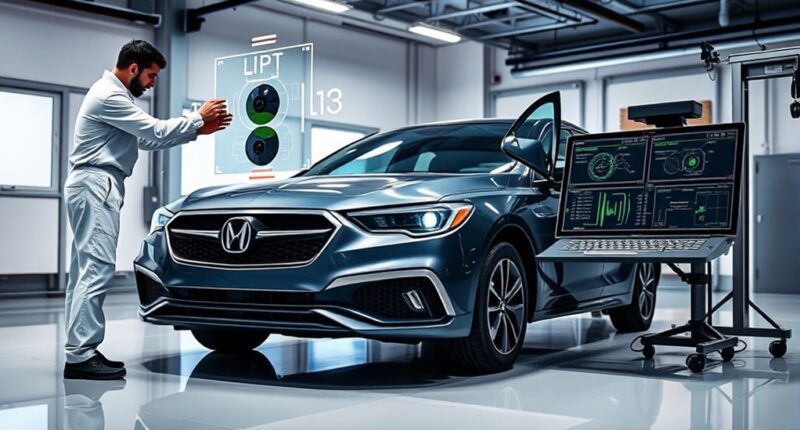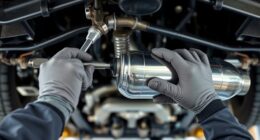After vehicle modifications, you need to verify your ADAS sensors, including cameras and radar, are properly calibrated to maintain safety and maximum performance. This involves using specialized tools and following manufacturer procedures to realign sensors, often with target panels or calibration targets. Software updates may also be required to keep the system functioning correctly. If you want to understand the specific steps involved and why they matter, there’s more to explore.
Key Takeaways
- Sensor realignment is essential after modifications to ensure accurate data for ADAS functions.
- Specialized calibration procedures and equipment are required to properly align sensors post-modification.
- Software updates may be necessary to maintain compatibility and enhance ADAS performance after changes.
- Verification with diagnostic tools confirms correct sensor calibration and software versions.
- Proper calibration and software maintenance prevent false alerts and ensure system safety and reliability.

Advanced Driver Assistance Systems (ADAS) have become essential for modern vehicles, enhancing safety and driving convenience. When your vehicle undergoes modifications—such as repairs, bodywork, or aftermarket upgrades—these systems often require recalibration to function correctly. One of the most critical aspects of this process involves sensor alignment. ADAS relies heavily on sensors like cameras, radar, and ultrasonic devices to monitor your surroundings. If these sensors aren’t properly aligned after modifications, their data can become inaccurate, leading to false warnings or even system failures. That’s why ensuring precise sensor alignment is crucial; even a slight misalignment can compromise safety features like automatic emergency braking or lane-keeping assist.
After any adjustment to your vehicle’s structure or sensors, you must verify that these sensors are correctly calibrated. This involves specialized equipment and trained technicians who can perform detailed calibration procedures, often using target panels or calibration targets to align sensors precisely. Proper sensor alignment guarantees that the ADAS components interpret their environment accurately, maintaining the safety standards you expect from your vehicle.
Alongside sensor alignment, software updates play a vital role in maintaining the effectiveness of your ADAS. Modern systems are driven by sophisticated software that needs to be current to handle new scenarios, fix bugs, and improve overall performance. When modifications are made, especially ones involving sensors or the vehicle’s electronic control units (ECUs), updating the software ensures that all components work harmoniously. Manufacturers regularly release updates that enhance functionality, address vulnerabilities, and improve sensor processing algorithms.
You should always check whether your vehicle’s software needs updating after any repair or modifications. This can involve visiting your dealership or a qualified service center that has the proper diagnostic tools. They’ll connect your vehicle to a computer system that can identify outdated software versions and install the latest updates. Keeping your software current not only improves system accuracy but also ensures compatibility with the latest calibration standards and safety protocols.
Frequently Asked Questions
How Often Should ADAS Calibration Be Performed After Modifications?
You should perform ADAS calibration immediately after any modifications that affect sensor alignment, like replacing or repairing sensors or structural components. Calibration frequency varies depending on the repair, but it’s best to verify sensor alignment and recalibrate as needed to guarantee safety and peak performance. Always follow manufacturer guidelines, and consider re-calibrating if you notice warning lights or if the vehicle’s sensors seem misaligned.
Can Non-Certified Technicians Perform ADAS Calibration?
You shouldn’t let non-certified technicians perform ADAS calibration. Proper calibration procedures require technician certification to guarantee safety, accuracy, and compliance. Certified technicians have the training and expertise to follow precise calibration procedures, reducing errors and maintaining vehicle integrity. Trust only qualified professionals to handle ADAS calibration after modifications, because your safety depends on accurate system adjustments and adherence to industry standards.
What Are the Risks of Improper ADAS Calibration?
If you perform improper ADAS calibration, you risk sensor misalignment and inaccurate system responses. This can lead to safety issues, like false alerts or failure to detect hazards. Software updates may also be compromised if calibration isn’t conducted correctly, affecting system performance. Always guarantee proper sensor alignment and calibration procedures are followed to maintain safety and system reliability, especially after modifications or repairs.
Are There Specific Tools Required for ADAS Calibration?
You absolutely need specialized tools, or your entire calibration process could go off the rails! For proper sensor alignment, you must use precise calibration equipment designed for ADAS systems. These tools guarantee that sensors are perfectly aligned and calibrated, preventing dangerous misreads. Without them, your calibration could be flawed, risking safety and vehicle performance. Investing in the right calibration equipment is essential for accurate, reliable ADAS functionality after modifications.
How Does Weather Impact ADAS Calibration Accuracy?
Weather notably impacts ADAS calibration accuracy by affecting sensor sensitivity. Rain, snow, fog, or extreme temperatures can distort sensor readings, making calibration less precise. You should increase calibration frequency after severe weather conditions and verify sensors are clean and unobstructed. Regularly check for calibration errors, especially during seasonal changes, to maintain ADAS performance and safety. Proper calibration helps your system adapt to varying weather conditions effectively.
Conclusion
Remember, a chain is only as strong as its weakest link. After modifications, ensuring your ADAS system is properly calibrated is essential for safety and peak performance. Don’t overlook the importance of following calibration requirements; otherwise, you risk compromising your vehicle’s advanced features. Stay proactive, stay safe—because in the world of modern driving, “an ounce of prevention is worth a pound of cure.” Proper calibration keeps your vehicle reliable and your mind at ease.









